What’s Up?
On Saturday, multiple IPT veteran Sandra Calderbank joined Bob Eastman and me for a morning of instruction at Sebastian Inlet. Following the #1 rule for wind against sun conditions, we arrived very early to be in position to work the sunrise. Here is how I helped Sandy set up for Shutter Priority with AUTO ISO with her v 2.02 firmware a-1:
1- Turn the ISO down one click past 50 to AUTO. (We both normally use the Thumb Dial for ISO when shooting in Manual mode.)
2- Move the Command Dial (if that’s what they call it) to “S” for Shutter Priority. Set a slow shutter speed for pre-dawn blurs, something in the neighborhood of 1/10 to 1/60 second.
3- In Custom Key/Dial Set assign Exposure Compensation to the Thumb Wheel. Turn the Thumb Wheel clockwise to add light, usually to between +1 to +2 1/3 stops depending on the tonality of the background.
When the sun comes out, you will want to get back to Manual mode with ISO on the Thumb Dial. Simply reverse the steps:
1- In Custom Key/Dial Set assign ISO to the Thumb Wheel.
2- Move the Command Dial (if that’s what they call it), to “m” for Manual mode.
3- Set the ISO (and the shutter speed and aperture) as usual and as needed.
It should be relatively easy to set up any Canon or Nikon camera to do the same thing:
1- Set the ISO to AUTO.
2- Assign Exposure Compensation to a convenient dial or wheel.
3- Set Shutter Priority.
To get back to manual mode, just reverse the steps.
We had a very nice sunrise. We struggled with the wind against sun conditions for the rest of the morning. While picking my keepers, I was pleasantly astounded by how many good images I had created on a day when conditions were far from ideal. Six of those images are shared with you in today’s post along with more than a few helpful lessons.
On Sunday morning, Bob and I enjoyed a spectacular sunrise. Bob worked almost exclusively on the beach with his 16-35 Sony lens. Working mostly with slow shutter speeds in Shutter Priority with AUTO ISO, I concentrated on the large Sanderling flock that fed along the shore and occasionally blasted off out over the waves. They put on an amazing show.
The morning turned crazy (again) with dozens of pelicans and ospreys diving on baitfish. With the NNE wind in our face, the birds were all flying away from us. We ventured out on the jetty, got drenched by waves, and in short order, left the jetty in fear of the waves breaking over it. Wet and shivering, we headed back to our AirBnB a few minutes after 8:00am!
Today is Monday 18 November 2024. I am looking forward to working with Steve Shore (again) and meeting and working with his wife Elisabeth for the first time. They flew from Dallas to Orlando and arrived at the AirBnB at about 7:30 last night.
Please remember to use the B&H links that are found on most blog pages and to use the BIRDSASART discount code at checkout when purchasing your new gear from Bedfords to get 3% back on your credit card and enjoy free second-day air FedEx. Please, also, consider joining a BAA IPT. You will be amazed at how much you will learn!
If an item — a Delkin flash card, or a tripod head — for example, that is available from B&H and/or Bedfords, is also available in the BAA Online Store, it would be great, and greatly appreciated, if you would opt to purchase from us. We will match any price. Please remember also to use my B&H affiliate links or to earn 3% cash back at Bedfords by using the BIRDSASART discount code at checkout for your major gear purchases. Doing either often earns you free guides and/or discounts. And always earns my great appreciation.
Supporting My Efforts Here
If you enjoy and learn from the blog, are all set for gear, or live overseas, consider leaving a BAA Blog Thank You Gift here.
If you enjoy and learn from the blog, please consider using one of my affiliate links when purchasing new gear. It will never cost you a single penny. To support my effort here, please order from B&H by beginning your search here. Or, click here, to order from Bedfords and enter the discount code BIRDSASART at checkout to receive 3% cash back to your credit card and enjoy free Second-Day Air Fed-Ex shipping. It is always best to write for advice via e-mail.
In many cases, I can help you save some serious dollars. And/or prevent you from purchasing the wrong gear from the wrong shop.
|
|
|
This image was created on 16 November 2024 on the Sebastian Inlet Ospreys and More Extended IPT. Standing on the beach at high tide, I used the hand held Sony FE 300mm f/2.8 GM OSS Lens (Sony E) with the Sony FE 1.4x Teleconverter, and The One, the Sony a1 Mirrorless Camera. The exposure was determined via Zebra technology with Exposure Compensation on the thumb dial. Shutter Priority -0.3 stops. AUTO ISO set ISO 100: 1/10 sec. at f/20 (stopped down 3 2/3 stops). AWB at 6:46:02am on a party cloudy morning just after sunrise. RawDigger showed the exposure to be dead solid perfect. Tracking Zone/AF-C with Bird Face/Eye detection enabled performed to perfection. Be sure to click on the image to enjoy the high-res version. Image #1: Sunrise sky/Atlantic Ocean abstract |
Un-Intentional Camera Movement Images
The term ICM (Intentional Camera Movement) has always bugged me. Why? It is possible to create pleasing blurs when you are (or are attempting to) keep the camera still. And you can create some nice blurs with the lens on a tripod and the subject or subjects moving be they avian or liquid. I was set up in Shutter Priority Mode with AUTO ISO looking to create some flight or wave blurs. When the sun peeked through an opening in the dark clouds, I forget to increase the shutter speed. I made a single frame at 1/10 second and then switched to 1/250 second and created some sharp versions. Note that with a sliver of red sky against an otherwise dark sky I needed a bit of minus Exposure Compensation (rather than my usual +2.0 EC).
The raw file was properly exposed but needed some TLC during the image optimization to bring out the potential I saw. When trying to create pleasingly blurred images, happy accidents are very rare but always welcome.
|
|
|
This image was also created on 16 November 2024 on the Sebastian Inlet Ospreys and More Extended IPT. Seated on the beach at high tide, I used the hand held Sony FE 300mm f/2.8 GM OSS Lens (Sony E) with the Sony FE 1.4x Teleconverter, and The One, the Sony a1 Mirrorless Camera. The exposure was determined via Zebra technology with Exposure Compensation on the thumb dial. Shutter Priority -1.7 stops. AUTO ISO set ISO 100: 1/250 sec. at f/9 (stopped down 1 1/3 stops). AWB at 6:50:12am on a party cloudy morning just after sunrise. RawDigger showed the exposure to be dead solid perfect. Tracking Zone/AF-C with Bird Face/Eye detection enabled performed to perfection. Be sure to click on the image to enjoy the high-res version. Image #2: Reddish Egret on berm |
Dealing With Wind Against Sun Conditions: Get Up Early!
The first rule of dealing with wind against sun conditions at beaches and lakes is to arrive early to take advantage of possible silhouette/backlit situations. With a west wind in the morning the birds will be flying toward you and away from the rising sun. Minutes after creating Image #1, this Reddish Egret landed on the berm so Sandy and I sat so that we could include the sky. The -1.3 stops EC is due to the fact that the raw file was a vertical that included the sun in the frame. Thus, after cropping this one to a horizontal I needed to open up the dark tones in Photoshop.
|
|
|
This image was also created on 16 November 2024 on the Sebastian Inlet Ospreys and More Extended IPT. Standing at the base of the South Jetty I used the hand held Sony FE 300mm f/2.8 GM OSS Lens (Sony E) with the Sony FE 2x teleconverter (at 600mm), and The One, the Sony Alpha 1 Mirrorless Digital Camera). The exposure was determined via Zebra technology with ISO on the thumb dial. ISO 1250. 1/2000 sec. at f/5.6 (wide open) in Manual mode. When evaluated in RawDigger, the raw file exposure was determined to be dead-solid perfect. AWB at 7:19:11am on a then mostly sunny morning. Tracking: lower center Zone AF-C with Bird Face/Eye detection enabled performed perfectly even at 1200mm. Be sure to click on the image to enjoy a high-res version. Image #3: Sanderling flock backlit blast-off |
Dealing With Wind Against Sun Conditions: Use the Strong Backlight
We were at the base of the South Jetty attempting to photograph some low-in-the-sky Royal Terns before they turned left and away from us into the NE wind. I fanned on one good diving chance and then turned around to look south. I adjusted my shutter speed to get a few blinkies on the breaking waves and said to Sandy, “I hope they blast off.” Five seconds later, they did.
The key to the success of this image was moving the zone brackets to the bottom of the frame so that focus would be on the birds at the bottom of the frame that were closest to me.
|
|
|
This image was also created on 16 November 2024 on the Sebastian Inlet Ospreys and More Extended IPT. I used the Robus RC-5570 Vantage Series 3 Carbon Fiber Tripod/Levered-Clamp FlexShooter Pro-mounted Sony FE 600mm f/4 GM OSS lens, the Sony FE 2.0x Teleconverter, and The One, the Sony Alpha 1 Mirrorless Digital Camera). The exposure was determined via Zebra technology with ISO on the thumb dial. ISO 1600. 1/3200 sec. at f/8 (wide open) in Manual mode. When evaluated in RawDigger, the raw file brightness was determined to be dead solid perfect. AWB at 8:01:56am on a mostly sunny morning. Zone/AF-C with Bird-Eye/Face Detection performed perfectly. Click on the image to enjoy the high-res version. Be sure to click on the image to enjoy a high-res version. Image #4: Osprey flying away with pinfish in its talons |
Dealing With Wind Against Sun Conditions: Experiment
The sun came out for a while. The Ospreys were kiting on the far side of the inlet, facing away from us, and catching an occasional fish. So, I figured what the heck and put the 2X TC on the 600. With the wind then from the north, the only thing available was the butt shot. Sometimes, they can work well. With the spread tail and the wings symmetrical, I like this particular butt shot. Go figure.
|
|
|
This image was also created on 16 November 2024 on the Sebastian Inlet Ospreys and More Extended IPT. Again I used the Robus RC-5570 Vantage Series 3 Carbon Fiber Tripod/Levered-Clamp FlexShooter Pro-mounted Sony FE 600mm f/4 GM OSS lens, the Sony FE 2.0x Teleconverter, and The One, the Sony Alpha 1 Mirrorless Digital Camera). The exposure was determined via Zebra technology with ISO on the thumb dial. ISO 2500. 1/4000 sec. at f/8 (wide open) in Manual mode. When evaluated in RawDigger, the raw file brightness was determined to be perfect. AWB at 8:14:30am on a then partly cloudy morning. Zone/AF-C with Bird-Eye/Face Detection performed perfectly. Click on the image to enjoy the high-res version. Be sure to click on the image to enjoy a high-res version. Image #5: Osprey kiting |
Dealing With Wind Against Sun Conditions: Pray for Clouds
A large cloud covered the sun for a few moments and the wind shifted to the east for just a bit. Long enough for me to increase my exposure and get on an Osprey to my left that was more or less facing me. I was quite amazed by the sharpness at 1200mm.
|
|
|
This image was also created on 16 November 2024 on the Sebastian Inlet Ospreys and More Extended IPT. Again I used the Robus RC-5570 Vantage Series 3 Carbon Fiber Tripod/Levered-Clamp FlexShooter Pro-mounted Sony FE 600mm f/4 GM OSS lens, the Sony FE 2.0x Teleconverter, and The One, the Sony Alpha 1 Mirrorless Digital Camera). The exposure was determined via Zebra technology with ISO on the thumb dial. ISO 640. 1/2000 sec. at f/8 (wide open) in Manual mode. When evaluated in RawDigger, the raw file brightness was determined to be perfect. AWB at 8:50:48 am on a then cloudy/very bright morning. Zone/AF-C with Bird-Eye/Face Detection performed perfectly. Click on the image to enjoy the high-res version. Be sure to click on the image to enjoy a high-res version. Image #6: Osprey in flight with fish/silhouette |
Dealing With Wind Against Sun Conditions: Think Way Out of the Box
We drove across the bridge to the Northwest Pool in hopes of getting an Osprey flying east with a fish in its talons. No luck there. Still with the 2X on the 600, I thought that I might have a chance of creating a late morning silhouette against the now cloudy very bright skies. The problem was that the entire inlet walkway north of the bridge is closed for nine months for the renovation of the North Jetty. The only option was to set up just north of the bridge and shoot over the chain link fence. As soon as I got set up and adjusted the exposure, an Osprey with a fish flew up to my right. I made three good frames on this pass. I called Bob and Sandy over but that was the last of it.
Some days everything seems to go right, even in lousy conditions.
Typos
With all blog posts, feel free to e-mail or to leave a comment regarding any typos or errors.

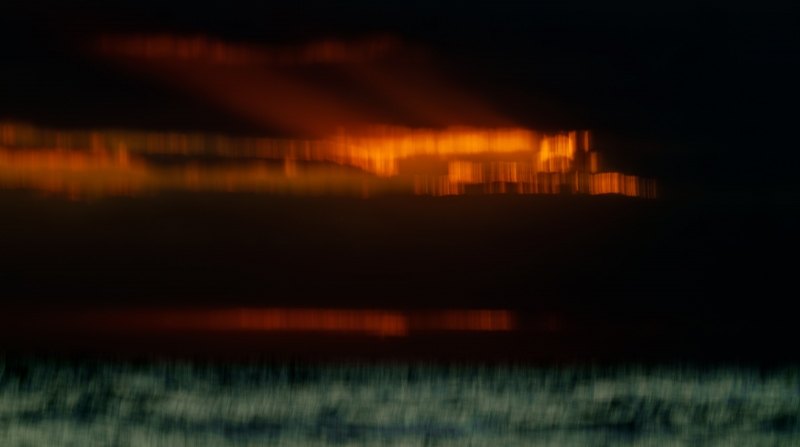
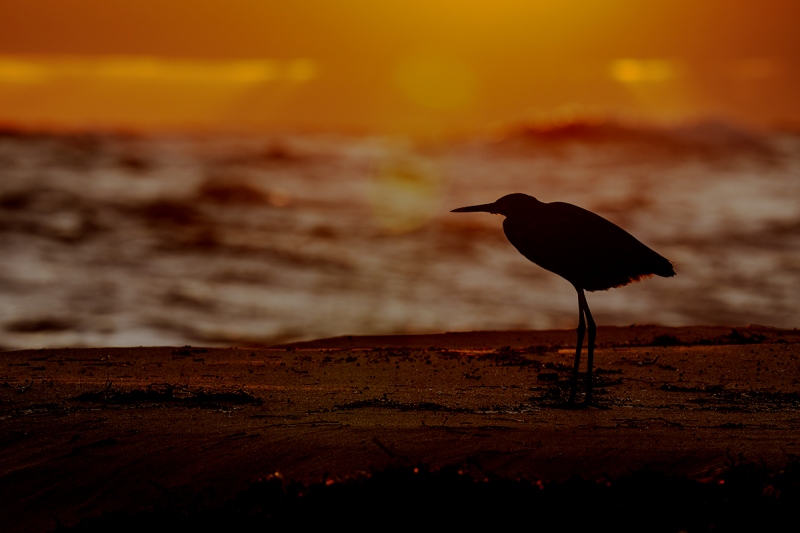
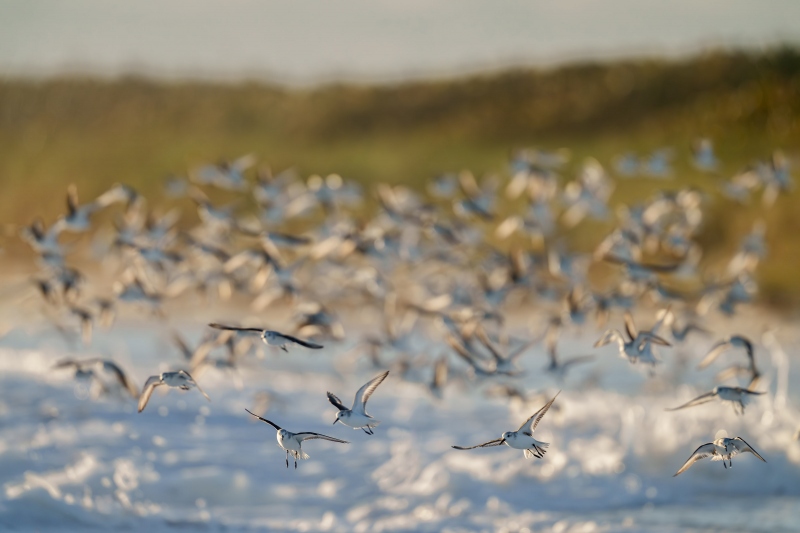
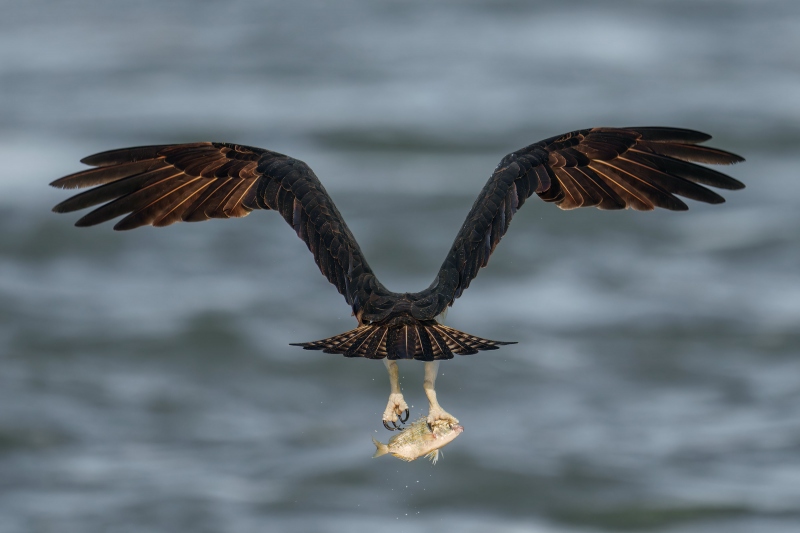
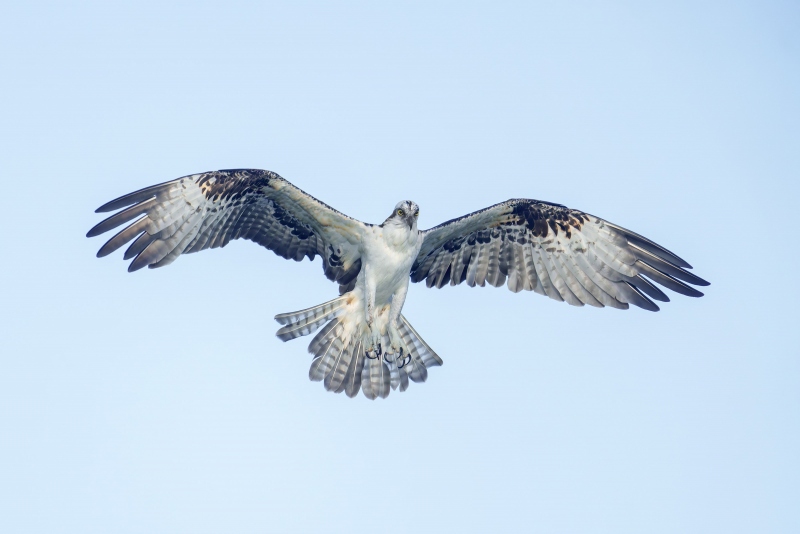
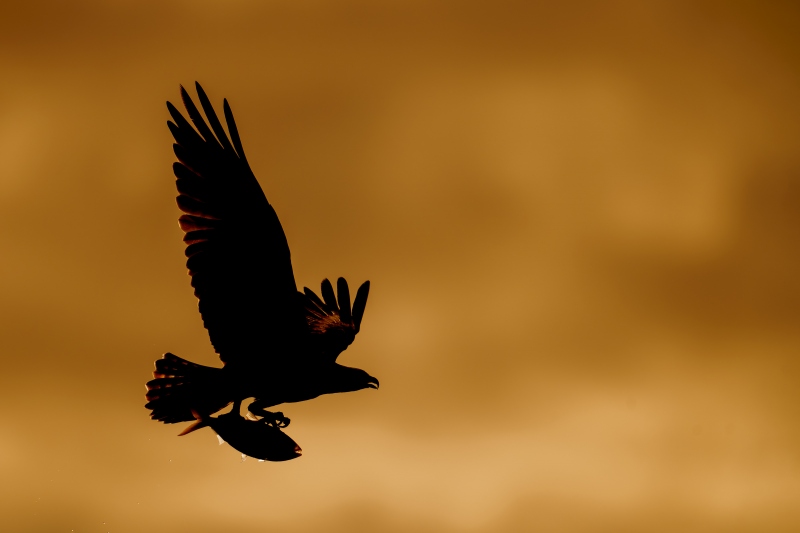













Image #1 reminds me of what happens when I accidentally press my shutter release when I’m not pointing my camera at anything and not intending to take a picture. I had to check today’s date to make sure it wasn’t April 1st.
Image #2 is quite good, although rather darker than I’d like.
Art: I had a hard time choosing between #5 and #6, but I’m going with the silhouette.